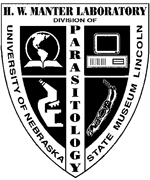Parasitology, Harold W. Manter Laboratory of

Harold W. Manter Laboratory of Parasitology: Library Materials
Document Type
Article
Date of this Version
6-22-2023
Citation
Experimental and Applied Acarology (2023) 90:301–316 https://doi.org/10.1007/s10493-023-00802-6
Abstract
Some mites of the family Haemogamasidae can transmit a variety of zoonotic diseases and have important public health and safety implications. Currently, however, little attention has been paid to molecular data of Haemogamasidae species, limiting our understanding of their evolutionary and phylogenetic relationships. In this study, the complete mitochondrial genome of Eulaelaps huzhuensis was determined for the first time, and its genomic information was analyzed in detail. The mitochondrial genome of E. huzhuensis is 14,872 bp in length with 37 genes and two control regions. The base composition showed a distinct AT preference. Twelve protein-coding genes have a typical ATN as the start codon, and three protein-coding genes have incomplete stop codons. During the folding of tRNA genes, a total of 30 mismatches occurred, and three tRNA genes had an atypical cloverleaf secondary structure. The order of the E. huzhuensis mitochondrial genome arrangement is a new type of rearrangement in Mesostigmata. The phylogenetic analysis confirmed that the family Haemogamasidae is a monophyletic branch and does not belong to a subfamily of the Laelapidae. Our results lay the foundation for subsequent studies on the phylogeny and evolutionary history of the family Haemogamasidae.


Comments
Open access.